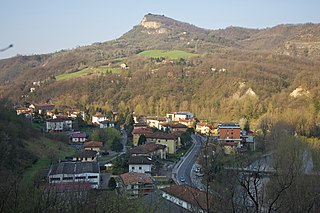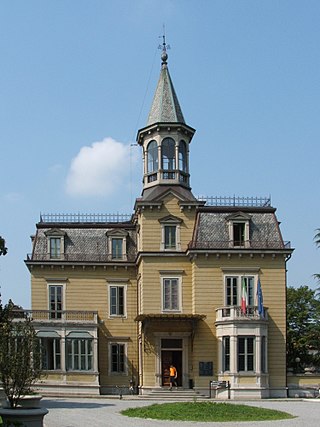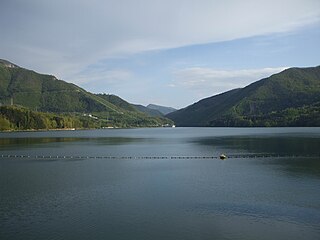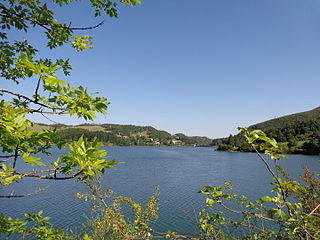
Schemmerhofen is a municipality ("Gemeinde") in the district ("Landkreis") of Biberach in Baden-Württemberg, Germany. Schemmerhofen is located in the Upper Swabia region of Baden-Württemberg.
The Battle of Zappolino, the only battle of the War of the Oaken Bucket, was fought in November 1325 between forces representing the Italian towns of Bologna and Modena, an incident in the series of raids and reprisals between the two cities that were part of the larger conflicts of Guelphs and Ghibellines. The Modenese were victorious. Though many clashes between Guelphs and Ghibellines loomed larger to contemporaries than to historians, the unusually-large encounter involved 4,000 estimated cavalry and some 35,000 foot soldiers, and 2,000 men lost their lives. The location of the battle, at the foot of a hill just outside the castle walls, is now a frazione of the municipality of Castello di Serravalle, Emilia-Romagna.

Monterenzio is a town and comune in the Metropolitan City of Bologna.

Monzuno is an Italian comune in the Metropolitan City of Bologna (Emilia-Romagna).

Capannori is an Italian town and comune in the province of Lucca, in northern Tuscany.
Villarbasse is a comune (municipality) in the Metropolitan City of Turin in the Italian region Piedmont, located about 20 kilometres (12 mi) west of Turin.
Illasi is a comune (municipality) in the Province of Verona in the Italian region Veneto, about 90 kilometres (56 mi) west of Venice and about 15 kilometres (9 mi) east of Verona. As of 31 December 2004, it had a population of 5,112 and an area of 25.0 square kilometres (9.7 sq mi).

Gromo is a comune (municipality) in the Province of Bergamo in the Italian region of Lombardy, located about 80 kilometres (50 mi) northeast of Milan and about 35 kilometres (22 mi) northeast of Bergamo. As of 31 December 2004, it had a population of 1,246 and an area of 20.0 square kilometres (7.7 sq mi).

Zanica is a comune (municipality) of around 8,804 inhabitants in the Province of Bergamo in the Italian region of Lombardy, located about 45 kilometres (28 mi) northeast of Milan and 7 kilometres (4 mi) south of Bergamo. Zanica borders the following municipalities: Azzano San Paolo, Cavernago, Comun Nuovo, Grassobbio, Orio al Serio, Stezzano, Urgnano.

Cavriana is a comune (municipality) in the Province of Mantua in the Italian region Lombardy, part of the municipalities of Alto Mantovano.

Mezzani is a comune (municipality) in the Province of Parma in the Italian region Emilia-Romagna, located about 90 kilometres (56 mi) northwest of Bologna and about 15 kilometres (9 mi) northeast of Parma. The principal centres of the municipality are Casale, Mezzano Rondani, Mezzano Inferiore, Mezzano Superiore, whereas Bocca d’Enza, Ghiare Bonvisi, Valle are only hamlets. Mezzani borders the following municipalities: Brescello, Casalmaggiore, Colorno, Parma, Sorbolo, Torrile, Viadana.

Gualtieri is a comune (municipality) in the province of Reggio Emilia, in the Italian region of Emilia-Romagna, located about 70 kilometres (43 mi) northwest of Bologna and about 25 kilometres (16 mi) north of Reggio Emilia on the right bank of the Po river. Historically, it suffered numerous floods, the last occurring in 1951. It is one of I Borghi più belli d'Italia.

Molinella is a comune (municipality) part of Metropolitan City of Bologna in the Italian region Emilia-Romagna, located about 30 kilometres (19 mi) northeast of Bologna.

Monteveglio is a frazione (village) in the comune (municipality) of Valsamoggia. It is located about 20 kilometres (12 mi) west of Bologna, near the Samoggia River, in the Italian region of Emilia-Romagna. It was an independent comune until 2014, when it merged with the neighboring municipalities of Bazzano, Valsamoggia, Castello di Serravalle, Crespellano, and Savigno. Monteveglio's main attractions are its pieve of Santa Maria and Oratory of San Rocco.

Stroncone is a comune (municipality) in the Province of Terni in the Italian region Umbria, located about 70 km southeast of Perugia and about 8 km south of Terni. It is one of I Borghi più belli d'Italia.
Valle di Maddaloni is a comune (municipality) of 2 661 inhabitants in the Province of Caserta in the Italian region Campania, located about 30 kilometres (19 mi) northeast of Naples and about 7 kilometres (4 mi) east of Caserta.
The War of the Bucket or the War of the Oaken Bucket was fought in 1325 between the rival city-states of Bologna and Modena. It took place in the region of Emilia-Romagna, in northern Italy. The war was an episode in the over 300-year-long struggle between Guelphs and Ghibellines. Modena won the Battle of Zappolino, the only battle of the war.

The Metropolitan City of Bologna is a metropolitan city in the Emilia-Romagna region of Italy. Its capital is de facto the city of Bologna, though the body does not explicitly outline it. It was created by the reform of local authorities and established by the Law 56/2014, replacing the province of Bologna. It has been operative since 1 January 2015.

Lake Suviana is an artificial lake located in metropolitan city of Bologna, Italy in the Bolognese Apennines, formed following the construction of a 91.5 m high dam, begun in 1928 and completed in 1932.

Lake Brasimone is an artificial lake located on the Bolognese Apennines along the Brasimone stream, in the municipal territory of Camugnano and is included within the Suviana and Brasimone.














